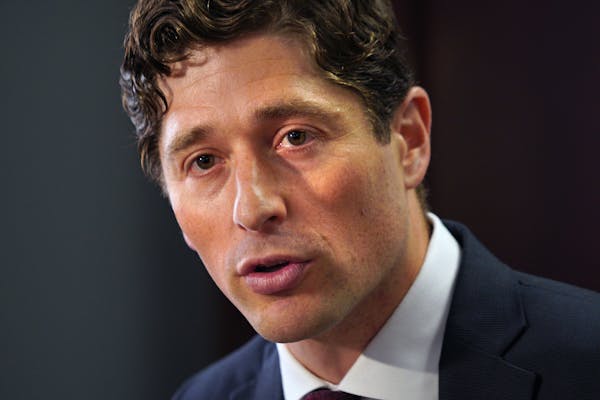Affordable rental housing construction is exploding in Minneapolis, according to figures trumpeted Wednesday by Mayor Jacob Frey and City Council members.
The record-setting pace of discounted housing for those struggling to make ends meet — and those on the edge of homelessness — is the result of hundreds of millions of dollars in taxpayer money, as well as what one developer calls "almost infinite" demand amid skyrocketing rents and home prices.
Here's what the boom looks like by the numbers:
Total new units
Between 2011 and 2018, the city averaged inking deals on 322 affordable rental units per year, just below the 349-unit goal set by the Metropolitan Council, which for decades has urged cities to figure out how to increase the supply of affordable housing.
From 2019 to 2021, the annual average had nearly doubled, reaching 634 new units.
In 2022, that figure was 919.
'Deeply affordable' units
Comparing the number of deeply affordable rental units, those intended for people with little money, including some people experiencing homelessness, the change is more pronounced.
The 2011-2018 annual average was 41 units.
In 2022, 264 such units were financed, a six-fold increase.
The numbers represent the closing of financing for construction of the rental units. Housing officials use the figure as a proxy for construction, since ground is usually broken soon after the financing is secured.
The spike in construction since 2019 is the result of about $320 million in taxpayer money, a combination of city funds and federal pandemic-era funds that were allowed to be spent on housing.
How it works
In the most typical scenario, the city offers cash to developers to construct the units on the condition they'll be leased to people below certain income brackets. Without that cash, officials said, it often doesn't make financial sense for developers to offer discounted rents.
There's no lack of a market, though, according to David Wellington, co-owner of Wellington Management, which is developing a number of affordable housing projects — for rent and purchase — across the city.
"These units will go very quickly," Wellington said. "The demand is almost infinite. The income inequality and the separation between the haves and have-nots, and the rising price of housing is pushing a lot of people into deeply affordable housing."
"Affordable rental housing" is generally defined as offering leases to those earning 60% of the area's median income or less.
"Deeply affordable" units cap the income at 30% of that median income. For a family of four today, that income threshold is around $34,000, according to Elfric Porte, the city's director of housing policy and development, and such a family wouldn't be required to pay more than 30% of their income on rent.
Federal housing subsidies, such as Section 8, typically pay the remainder of the rent.
Why it's a big deal
As Minneapolis continues to grapple with homeless encampments and renters witness a parade of rent increases amid the inflation of the post-pandemic economy, officials see increasing the supply of affordable rental units as one of the most tangible things they can do in response.
Frey came into office in 2018 with housing affordability atop his agenda. While he and some of his fellow elected city leaders disagree on some policy, such as the possibility of rent control, the view that tax dollars needed to be spent to preserve existing housing — and help build new, inexpensive units — was widespread on the City Council.
The result was that recent city budgets have significantly increased funding for such projects and have directly led to the changes touted Wednesday.
"This is among my proudest days as mayor," Frey said at a news conference in north Minneapolis. He announced the figures in a glass-walled office building overlooking a former industrial site where Wellington-contracted backhoes prepared the ground for several buildings. There will soon be more than 100 affordable and deeply affordable rental units, as well as some 17 townhouses for purchase.
He was joined by City Council Members Jeremiah Ellison and Michael Rainville, who both praised the news.
Ellison, who said "the numbers speak for themselves," noted that the current view on building new affordable units has shifted in recent years.
"In 2017 when I ran for City Council, it was a little bit controversial to say you wanted affordable housing in north Minneapolis," he said, noting the area has some of the lowest-priced housing stock in the city. "Some people thought it needed to go elsewhere, but I think bringing in new units like this will have a stabilizing effect."
Is it enough?
While city leaders also said another 2,112 new affordable rental units are in the pipeline, some renter advocates said it's nowhere near enough.
Home to Stay, a group pushing for rent control, said rents will continue to price more people out than the new units can keep up with.
"Home to Stay deeply appreciates the investments of Mayor Frey's administration in public and affordable housing," the group said in a statement Wednesday. "While these are truly important, the majority of renters do not benefit from these investments. On their own, affordable housing developments fail to meet the scale and urgency needed to keep Minneapolis renters housed."

Lino Lakes considers temporarily halting proposed development that includes a mosque
Neal: A legend exits the Twin Cities pro boxing scene

Hennepin County commission primary narrows Edina-area seat to two

Lakeville teachers file intent to strike, picket outside school board meeting

